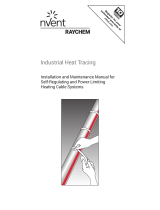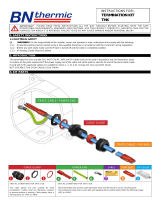
nVent.com/RAYCHEM | 7
Table 2: Typical cable limits of power output
Maintain
temperature (°C)
Typ� max� cable load (W/m)
Good contact
Poor contact
XPI/XPI-S XPI-F XPI/XPI-S XPI-F
≤ 10 30 25 25 20
+ 11...30 25 20 20 15
+ 31...50 21 18 18 13
+ 51...75 18 - 15 -
+ 76...100 15 - 12 -
+ 101...125 12 - 10 -
+ 126...150 10 - 8 -
+ 151...200 8 - 5 -
The typical cable power output is shown above in table 2, depending
on application. The maximum cable power output is directly dependent
on the application and control method used. The actual limits of PI
heating cables in a specific application are given in Engineering Software
(e.g. TraceCalc Pro design software). Contact nVent for more details.
Ensure that the heating cable voltage rating is suitable for the
service voltage available and that the temperature rating of the
heating cable defined by the design is suited for theapplication.
Check equipment to be traced:
Check identification, dimensions of pipework /vessel,
actual temperatures and insulation properties against the
designdocuments.
Ensure all pressure testing of pipework/vessel is complete and
final paint and pipe/vessel coatings are dry to touch.
Walk the system and plan the routing of the heating cable on the
pipe, including tracing of heatsinks. e.g. valves, flanges, supports,
drains etc.
Inspect piping for burrs, rough surfaces, sharp edges etc. which
could damage the heating cable. Smooth off or cover with layers
of glass cloth tape, aluminium foil or rubber profiles (e.g. G-02).
Ensure that the heating cable voltage rating is suitable for the
service voltage available and that the temperature rating of the
heating cable defined by the design is suited for theapplication.
Changing any major design parameters like voltage or cable length
will result in power output other than designed, which may require a
redesign of the entire system. To prevent overload of the heating cable,
fire or explosion in hazardous areas, verify that the maximum sheath
temperature of the heating cable is below T-class or auto-ignition
temperature of the gases and/or dusts possibly present in those areas�
For further information, see design documentation (e.g. TraceCalc Pro
reports)�
Check the design specification to ensure the proper heating cable is
installed on each pipe or vessel.Refer to RAYCHEM product literature to
select an appropriate heating cable for each thermal, chemical, electrical
and mechanical environment.
Storage and transportation
Store and transport product in a clean, dry place
Temperature range: -70°C for XPI and XPI-S, -60°C for XPI-F
to +56°C for all
Protect the heating cable from moisture or mechanicaldamage
Keep ends of heating cables and kit components dry before and
during installation.


























